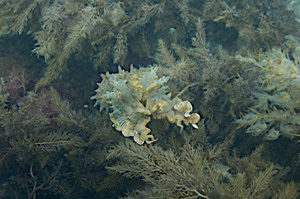
Sepia apama (giant Australian cuttlefish) expressing its papillae for camouflage purposes. Courtesy of Roger Hanlon.
WOODS HOLE – Octopi and cuttlefish can instantly change their skin color and pattern to blend in to the environment and engineers have now invented a synthetic “camouflaging skin” inspired by the marine creatures.
The cephalopods swiftly morph their skin into a textured, 3D surface, allowing them to mimic seaweed, coral and other objects.
Engineers at Cornell University, working with cephalopod biologist Roger Hanlon of the Marine Biological Laboratory in Woods Hole, have invented stretchable surfaces with programmable 3D texture morphing.
The team presented its controllable soft actuator in a recent issue of Science.
The pneumatically activated material pulls from the 3D bumps, or papillae, that cephalopods can express in one-fifth of a second for camouflage and then retract to swim away with minimal drag.
Lead author of the study James Pikul, from the University of Pennsylvania, says the engineers wanted to develop a way to control the shape of soft, stretchable materials in a simple way that is fast and easy to use.
Hanlon says the material has a wide range of applications and can be controllably morphed to reflect light in its 2D spaces and absorb light in its 3D shapes.























